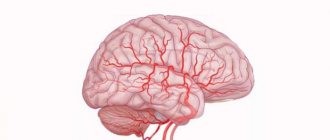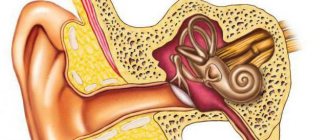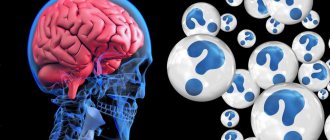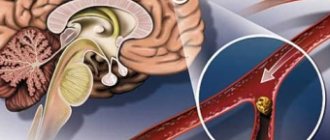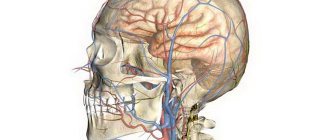HYSTERIA
(
hysteria
; Greek, hystera uterus) is a type of psychogenia that occurs in connection with a psychotraumatic situation in persons with a special character (hysterical character) and in previously healthy people in severe psychotraumatic conditions. It often appears at a young age, mainly in women, although men also get sick. It is expressed in numerous functional disorders with very polymorphic symptoms, externally reminiscent of a variety of diseases, for which it has received the name “a chameleon that constantly changes its colors” (T. Sydenham), “the great malingerer” (J. Charcot), “the iliad of all diseases” etc. The peculiarity of those suffering from I. is the desire to attract the attention of others in any way and a very high suggestibility and self-suggestibility.
Causes
The main triggers for female emotional outbursts include:
- Chronic overwork - unfortunately, today many women are forced to provide not only for themselves, but also for their children. Each representative of the fair half of humanity bears a truly gigantic burden of responsibilities - not only professional, but also domestic. in this case it acts as a kind of release - in this way the woman simply throws off accumulated fatigue.
- Following the fashion trends that have developed in society - trying to maintain themselves in a certain shape, and now a thin figure is considered beautiful, many beauties deny themselves proper nutrition. Their diet simply does not contain fats and carbohydrates in the amount required to maintain a healthy nervous system. Sometimes a woman’s hysteria is only a direct consequence of banal malnutrition.
- A simple lack of time for yourself - the need to take care of everyone and everything is inherent in women by Mother Nature. It’s just that for some it comes to excessive forms - they help everyone except themselves. Outbursts of aggression are only harbingers of impending hysteria. You need to learn to distribute your time so that you have precious minutes left for yourself, the one and only.
- Irregularity or complete absence of intimate life - the body of Eve’s daughters is designed in such a way that intimate life acts as a physical as well as psychological feed for their emotional balance. And one “spark” is enough - the absence of sex for a certain period for the body to rebel and give out a lot of negative emotions.
The reasons for female hysterics can be different. The above is not a complete list of them. In order not to deal with such consequences, it is better to take care of the psycho-emotional health of your chosen one in advance - pay her more attention and love.
How to respond to female hysteria
Many representatives of the stronger half of humanity, due to the peculiarities of their thinking, believe that hysterical outbursts in women arise out of nowhere. This misconception is fundamentally wrong. By simply ignoring the hysteria, a man thereby achieves the exact opposite result - his chosen one will certainly calm down, but will long remember the fact that her “cry from the soul” was left without proper attention and support.
Not many men understand how to react correctly to a woman’s hysteria. There is no point in demanding reasonable arguments and explanations at this moment. This is a pointless activity - the woman simply does not control herself at this moment. She throws out all the negativity accumulated inside her and simply cannot cope with it.
A man can only listen and show maximum attention and empathy. Compassion and love are appropriate in such a situation. Paying attention to words is the key to understanding the problem.
As a rule, a woman at the moment of hysteria directly states that she was brought to such a state. Following from this, a man must react - if a woman needs a strong shoulder on which she can cry, then substitute him. If she wants some specific promises, for example, a vacation trip to the warm sea, then she should clearly state whether the desire will be fulfilled.
Such manipulative hysterics sometimes become the norm in some families. Therefore, they can be ignored by men. Sometimes this is a special personality type, their nervous system, an anomaly that leaves an indelible imprint on a person’s personality. Such ladies can literally in a second work themselves up so much that they no longer control their behavior. The best tactic in this case is to listen, agree, and do it your way.
Therapy
Treatment of hysteria in women is mainly psychotherapeutic. The psychotherapist must find out the reasons that led to the formation of hysterical neurosis in a woman. One of the important points in the treatment of female hysteria is the normalization of her sex life and harmonization of relations with her husband. Many women with hysteria need to consult a sex therapist.
The basic principles of treatment of female hysteria are aimed at eliminating psychotraumatic situations and strengthening the nervous system - maintaining a sleep and rest schedule, a balanced diet, eliminating various types of intoxication (in particular alcohol), relaxation therapy (physiotherapy), and playing sports.
Some women are advised to consult a gynecologist, who can prescribe medications to normalize her natural hormonal levels and reduce vegetative manifestations. Sedative therapy is prescribed, mainly herbal preparations (motherwort, valerian), various sedative herbal mixtures, as well as Novopasit, Persen, Corvalol, Afobazol, Grandaxin and others.
Female hysteria is a special emotional state that is practically uncontrollable, usually accompanied by raising the voice to individually high parameters, crying, and excessive gesticulation.
Most representatives of the stronger half of humanity, faced with such emotional manifestations, are lost and have no idea what to do. And it’s not surprising - in just a few minutes, an affectionate and caring woman turns into a screaming vixen waving her arms. To understand how to deal with this, you need to know what can provoke hysteria and avoid such situations in every possible way.
How to deal with female hysteria
The tendency to emotional outbursts is traditionally considered the prerogative of the fair half of humanity. However, one should distinguish between hysteria caused by stress or problems and hysteria. The latter does not always need to be encouraged. It is better to anticipate an outbreak of negative emotions in advance and try to stop it at the very beginning of its appearance.
How to stop female hysterics:
- if there is no time for rest, take on at least part of the daily burden, for example, buying groceries for the family and walking the dog, so that your loved one can devote more time to herself;
- take care of a balanced and proper diet - prepare dinner from light, low-calorie, but nutritious foods;
- take your significant other during vacation somewhere away from everyday life, of course, focusing on the family budget, but even a week without household pots will benefit the woman;
- compensate for dissatisfaction with sex life with romantic dinners and hot sex by candlelight;
- if the reason lies in physiology - the premenopausal time of life has arrived, it is better to seek professional help from a gynecologist; well-chosen hormonal therapy simply works wonders for the female psyche.
Under no circumstances should you leave your “other half” alone with the problem. If you ignore hysteria, you may encounter even greater problems in the family - it can be destroyed by misunderstanding and accumulated grievances. By understanding and eliminating the cause, a man will strengthen the marriage and create psychological comfort and coziness for himself.
Not all women are hysterical by nature; sometimes this is their only manifestation of overwork and a cry for help. And you can prevent outbursts of rage in your loved one by simply paying attention to her problems - not far-fetched, but real. So, it is enough to go for a walk in the park in the evenings or give pleasant little things that speak of love, for example, aromatic bath salts or a new hair clip. Yes, sometimes a simple conversation at dinner about what happened during the day will already indicate a man’s attention to the concerns and affairs of his chosen one, which she will certainly appreciate.
Hysteria is a mental disorder resulting from intense anxiety. It is characterized by a lack of control over acts and emotions, and sudden emotional outbursts. This is often the result of a depressed state within a person. This disease occurs in both sexes, but is much more common among young women between the ages of fourteen and twenty-five. One of the main reasons is the fact that their bodies undergo rapid changes during pregnancy, resulting in hormonal imbalance. When someone is experiencing an attack of hysteria, it is necessary that people around them do not panic and remain calm. Outbursts of hysteria are not uncommon, but it is necessary to identify the stimulant that is causing the hysteria before helping the person overcome his fears.
Symptoms of hysteria include heaviness in the limbs, severe cramps, rapid breathing, difficulty breathing, tightness in the chest, palpitations, a feeling of a foreign body in the throat, swelling of the neck and jugular vein, suffocation, headache, clenched teeth, muscle tension, an inexplicable desire to let off steam.
In severe cases, additional symptoms are noticeable as they may include wild and painful screams, incomplete loss of consciousness, swelling of the neck, rapid heartbeat, involuntary muscle contractions, frightening generalized convulsions, and violent movements. Prominence of veins in the neck often occurs when a person is experiencing hysteria.
Physical symptoms include weakness of will, a desire for love and affection, and a tendency toward emotional instability. The hysterical trance can last for several days or weeks. The patient in a trance state may find himself in deep sleep, but the muscles usually do not relax. Emotional instability and weakness of will can become extremely dangerous for those suffering from hysteria because it leads them to depressive thoughts.
Heredity plays an important role in its causation. Nervous situation in the family. Emotional situations, stress, fear, anxiety, depression, trauma, masturbation, and long-term illness can provoke hysteria. Anxiety is the main cause of hysteria; it is advisable that people who suffer from anxiety avoid very stressful situations.
Hysteria treatment using honey
Honey is considered an effective remedy for hysteria. It is advisable to eat one tablespoon of honey per day. Honey breaks down triglycerides, which cause blockages in the heart valves, thereby avoiding or minimizing the occurrence of high blood pressure. Since blood flow through the heart is unrestricted, blood pressure remains normal and hysteria can be avoided when difficult situations arise.
Hysteria treatment using lettuce
Lettuce is considered valuable in this disease. A cup of fresh lettuce juice, mixed with a teaspoon of gooseberry juice, should be drunk every day in the morning for a month, as a medicine to treat hysteria. While eating salad and fresh vegetables may not be directly related to hysteria, eating salad and fresh vegetables will help cleanse the body of toxins that may be causing health problems.
Help from a psychiatrist
The following herbs are recommended for this disease:
- Sage
- Motherwort
- Butterbur
The causes of female hysterics are thoughtfully studied by specialists in various fields - from psychologists to endocrinologists. Previously, attacks of hysterical inadequacy were easily treated - with a slap in the face. Now they are subject to respectful understanding from others. And if from time to time you break down and start screaming, we can probably find you a decent excuse.
- As soon as progressive humanity added the word “hormones” to its active vocabulary, life became much more interesting. Hormones can be blamed on excess weight, acne, depression... In fact, the real disease will be the only tiny case in a million. The remaining 999,999 cases are explained by simple laziness.
Version:
The causes of female hysterics are associated with a sharp drop in estrogen levels.
Every month, a week before day X, a girl has the unwritten right to wear out those around her due to the inevitable PMS. The girl's hormone balance is critically imbalanced - she needs to be understood and forgiven.
In fact:
A number of studies have measured estrogen levels in women during another critical period for women's mood - menopause. The studies involved both patients suffering from neuroses and those remaining calm. Tadamm! – the level of female hormones in both groups turned out to be the same! Which seems to hint: it is not estrogens that push us into the abyss of scandal. Proponents of different theories agree on one thing: if PMS interferes with normal life, the condition must be corrected - with vitamins, hormones, psychotherapy... The task of a hysterical person is to consult a specialist in time and give yourself (and those around you) a chance to find out how wonderful life is without hysterics.
And then what?
Everyone experiences mood swings due to hormonal fluctuations. But only those who have not found a socially acceptable outlet for negativity take it out on their neighbors. Play sports, write a sad poem, post it to a community of sympathizers... In the end, instead of a scandal, you can have sex. Moreover, many consider it another hormonal mood factor
Version: One of the reasons for female hysterics is a consequence of sexual dissatisfaction.
If previously it was supposed to look for truth in disputes or, at worst, in wine, then the sexual revolution opened everyone’s eyes: the truth is in sex. Is the woman okay? So the night was over. Is the woman feeling bad? She probably hasn't had sex for a week.
In fact:
Practicing gynecologists do not consider a long break from sexual activity to be critical for women's health.
During sex, nothing happens to us that cannot be achieved without intercourse: orgasm is the work of skillful hands, and endorphins can be obtained in the gym or in the nearest coffee shop with chocolate cakes.
Even oxytocin, which gives a feeling of peace and satisfaction, is not necessarily the result of sex: modern research proves that sometimes the voice of a loved one is enough.
And then what?
Dissatisfaction, of course. But not a lack of reciprocating movements, but a discrepancy between the desired and the actual. The girl doesn’t feel attractive, needed, loved – and that’s why she freaks out. This is much easier to believe than the pathogenic effects of abstinence. Especially to me, the imperturbable wife of a sailor who has been away from home for four months.
- For those who find the physiological details of a hysteria too complex or unpleasant, advanced “science” has carefully prepared a sophisticated, modern version. It is in great demand in our age of werewolves and ghouls.
Version: Hysteria is energy vampirism.
When, rolling your eyes, you tragically declare yourself an energy vampire, you seem to yourself to be a twilight diva. Power over people, an evil fate doomed to suck out energy... And I would be glad not to make a scandal, but such is the natural essence: only by ruining someone’s life, you briefly find harmony.
In fact:
Popular psychology, of course, is still a science, but - in the case of sucking out the brain... sorry, energy - it places emphasis more wisely. Experts have the term “psychological sadism.” It is not dark forces that make a hysterical woman infuriate those around her, but solely the desire to make fun of her. True, naive healers of souls believe that a sadist may not be aware of his sweet peculiarity... But psychologists by virtue of their position are supposed to believe in goodness.
And then what?
With energy vampirism it’s like with being overweight: you can tell everyone about heredity and big bones, or you can give up flour and sweets. You can yell at your husband or colleague, or you can pull yourself together and achieve calm with the help of yoga or psychotherapy, for example.
Version: The causes of female hysterics are an immanent property of the hysterical personality type.
Possessed but psychologically savvy ladies believe that the hysterical personality type that prompts them to scream, break cups, and yell at innocent people is like karma, which cannot be avoided.
In fact:
Personality is not so much temperament as it is the choice of how to use it. Indeed, people of the hysterical type create scandals out of a desire to be the center of attention. But at the same time, other people of the hysterical type read poetry from the stage, go to rallies, and burst out with ideas at brainstorms.
And then what?
Laziness, as usual. After all, in order to stop bullying others and find a socially acceptable source of satisfaction, you need to work on yourself, study, strive, achieve... PR, journalism, politics, acting - any public sphere will give you satisfaction and save those around you from causeless screams. As a last resort, you can shave your head and wear a red dress - you will definitely be noticed.
- And finally, a few more weighty excuses for the scandal that you have caused today or are about to cause:
Trite: everyday life.
Sometimes even the most wonderful and self-possessed girls go into a tailspin of scandal - for no apparent reason or history of bad tendencies. Because the time now is so... alarming.
Perfectionism.
To be the best lover, a promising business woman, a gentle mother and still have time for a manicure - how can you not yell at anyone who dared to stand in your rapid path to success? Let them not get under your feet!
Fatigue.
Heroic sleep for four hours a day, the inability to relax during the day, eating on the run and other sacrifices in the name of success quite quickly lead to a depleted immune system and diseases that may not knock you down, but weaken the nervous system.
And generally speaking!
How not to become hysterical when there are so many objective reasons to happily lash out at the first person you meet?
Human nature is multifaceted. Some emotions and character traits are usually attributed to women. However, not everything is so simple. Just because women often express something does not mean that men cannot express it. Hysteria is considered both a painful condition and an everyday whim. You should consider its symptoms, causes and methods of treatment.
Hysteria comes in different forms: psychological and everyday. In the first case, we are talking about a disease that relates to psychoneurological disorders with the manifestation of a whole complex of symptoms:
- Tears.
- Headache.
- Laughter.
- Spasms.
- Screams.
- Deafness and blindness.
- Cramps.
- Sobs.
- Confusion of consciousness.
About 8% of the population suffers from hysteria. The most severe form of this disease is hysterical psychopathy. The most important sign of this disease is a hysterical attack, when a person screams, cries profusely, arches, etc. It should be noted that this type of behavior is not acted out. Usually the first attacks appear in childhood. If parents notice certain signs of hysteria, then they should contact a child psychoneurologist.
If we are talking about everyday hysteria, then everything is much simpler. We are talking about a character trait or even about a staged performance that is intended specifically for a specific person. Specialists from the psychological help website even give clear advice to people at whom the hysteria is being played out - ignore it, don’t pay attention.
As they say, the performance lasts only as long as the audience participates in it and reacts to it. If there are no spectators, then the performance will stop. This advice is especially important in relationships between children and adults, where children should be weaned from hysterical behavior, as well as between lovers, where one partner tries to manipulate the other through hysterics.
Treatment
I.'s therapy should be comprehensive and consist of: 1) restorative treatment - balneotherapy (see), correct daily routine, physical therapy (see), electrosleep (see), glucose with vitamins, etc.; 2) prescribing various sedative medications, Ch. arr. tranquilizers (see) or small doses of neuroleptics (see), and according to indications - sleeping pills; 3) active psychotherapy (see) - individual and collective; In particular, various options for suggestion and self-hypnosis are shown, including autogenic training, as well as narco-psychotherapy. Hysterical seizure II can be stopped with an injection of chlorpromazine; in some cases, a sudden irritant helps - an injection, washing with cold water, etc.
Forecast
generally favorable, especially with timely and correct treatment.
Prevention
consists in the timely implementation, first of all, of psychohygienic measures, in the prevention or, if possible, elimination (after identifying their nature) of psycho-traumatic influences.
What is hysteria?
In the old days, hysteria was attributed only to the female sex. It was also called “rabies of the uterus” and “hysterical neurosis.” Today, psychologists note hysterical attacks in men as well. What is hysteria, which is common to both sexes? Hysteria is a mental disorder that is accompanied by autonomic, motor, functional and affective disorders in human behavior.
Hysteria arises on the basis of self-hypnosis and is aimed at attracting attention to oneself.
Today, hysteria is considered a disease that is inherent in both women (who were previously attributed this condition as one of the types of behavior) and men. It is necessary to distinguish the painful state from the everyday behavior of hysteria. In the first case, we are talking about a disease that cannot be cured without the help of a specialist. In the second, all you need is the help of a psychologist and drastic, decisive actions on the part of those at whom the hysteria is directed.
How does household hysteria manifest itself? A hysterical person easily succumbs to disappointment and imagines himself omnipotent. Unconsciously, he is sure that the world was created for him and people should fulfill his every whim. Such a person, being domineering, demanding and selfish, exaggerates everything, making mountains out of molehills. He does not tolerate objections, so he uses all sorts of tricks: he constantly cries, sobs, puts on theatrical performances, hoping for compassion, or pushes people away by insulting them, showing emotional or physical aggression. In essence, he behaves like an ill-mannered and capricious child who is trying to get what he wants at any cost.
There are several types of hysteria, which even lead to the appearance of real symptoms of fictitious diseases. Thus, in medicine, “hysterical pregnancy” is known - an enlargement of the abdomen in the absence of a fetus. There are also “hysterical paralysis” and “hysterical blindness”. All this is mentioned only to demonstrate what such a disorder can lead to. It is interesting to consider how this hinders fulfillment in love if one of the partners behaves irrationally or childishly.
According to experts in this field, the real cause of hysteria is the fear of incest, that is, the fear of a woman having sexual relations with her father or, in the case of a man, with her mother. All this is connected with the Oedipus complex and fear of castration. On the one hand there is attraction, on the other there is repulsion due to the fact that the partner in some way reminds him of the parent of the opposite sex. Such complexes also provoke theatricality and effects, with which, for example, a woman unconsciously tries to attract the attention of her father and gives vent to her emotional outbursts only when she has a suitable audience.
The law is this: without an audience there is no hysteria, the show is never performed alone.
The hysterical person is by no means frigid or impotent, but, on the contrary, passionate, but restrains his sexuality because he associates sexual intercourse with the danger of incest and suppresses himself until he explodes, giving vent to sexual tension through emotions. If this is repeated often, it leads to the formation of more or less stable patterns of behavior.
Hysteria is something like an emotional orgasm. In love relationships, it is usually associated with jealousy and awakens rough, lustful impulses. A jealous, hysterical person resorts to the most terrible insults, humiliating his partner, and arouses in himself a hidden, gross sexual arousal.
Nature of the pathology
Just a few decades ago, hysteria was considered an exclusively female pathology.
Popularly, this disease has received such names as “hysterical neurosis” and “uterine rabies.” A more in-depth study of the disease revealed that some signs of hysteria are also characteristic of the stronger sex. Today, hysteria is characterized as a complex mental disorder. The pathology may be complicated by affective and functional changes in human behavior patterns. The emergence of pathology is facilitated by high self-hypnosis and the desire to constantly be in the center of attention of others.
According to experts, the disease in question is more common in women. Psychologists talk about the importance of having the ability to distinguish signs of illness from everyday forms of manifestation. In the case of mental illness, the patient needs immediate psychotherapeutic help. And in situations related to everyday manifestations, it is important to direct all efforts to change a person’s personality. In this case, the decisive role is assigned to those people in whose direction the hysterical attacks are directed.
The everyday form of hysteria is formed on the basis of various disappointments and excessively high self-esteem. In such a state, people have a strong belief that the world revolves around them, and the purpose of those around them is to fulfill any whims. People with this type of behavior are characterized by such qualities as selfishness, demandingness and authority.
The purpose of the “concert” is to evoke a feeling of compassion among others. In some cases, not finding sympathy, a person may become embittered and begin to take out aggression on others.
This behavior can be compared to children's whims, when a child uses tears to achieve what he wants. Hysteria in psychology is a complex disease that has many different forms of manifestation. There are several forms of diseases that are accompanied by the formation of clinical signs characteristic of fictitious diseases.
One of these forms is “hysterical pregnancy,” which is characterized by an enlarged abdomen in the absence of an embryo. In addition, there is “hysterical paralysis” and “hysterical loss of vision.” The need to mention these pathologies is explained by the importance of demonstrating the danger of the disease.
Let's look at how hysteria becomes a barrier to personal fulfillment in relationships with the opposite sex. According to experts, the real reason for the formation of hysteria is the fear of incest, which is expressed in the form of fear of sexual relations with close relatives. Experts say there is a close relationship between hysteria and the Oedipus complex.
A person is under the power of attraction and repulsion, since the other half has specific personality traits that are characteristic of one of the patient's parents. The same complex leads to the emergence of a “game for the public”, the task of which is to attract the attention of parents and throw out the accumulated negativity in the presence of a suitable audience.
Hysteria is characterized by great self-hypnosis and the desire to attract the attention of others.
Psychologists point out that attacks of hysteria occur only in the presence of spectators. People prone to hysteria constantly restrain their emotions, which sooner or later leads to their spontaneous outburst. Frequent repetitions of emotional outbursts contribute to the formation of a certain pattern of behavior. Female hysteria is one of the ways to achieve euphoria, thanks to the release of accumulated emotions.
What are the causes of hysteria?
Psychologists attribute various internal and external factors to the causes of hysteria. In many ways, everything depends on the emotional component of a person and his personal qualities. Suggestibility plays a significant role, which affects the course of thoughts of a hysterical person and his emotional state.
Hysteria is attributed to a consequence of the complex development in which a person finds himself, or to nervous overstrain, which often arises from the need to restrain one's own emotions. Let us remember that a person is taught not to show his emotions, not to show negative feelings, to restrain himself. Society itself develops hysteria in a person, since emotionally weak people are not able to restrain themselves for long. Repressed emotions sooner or later break out, which makes a person behave inappropriately.
Factors contributing to the development of hysteria include:
- Physical overexertion.
- Unfavorable family situation.
- Dissatisfaction with life or professional sphere.
- Excessive use of tranquilizers or sleeping pills.
- Injuries.
- Alcohol abuse.
- Narcissism.
- Schizoid psychopathy.
- Excitable psychopathy.
Psychologists call the main reasons for the appearance of a large number of hysterical people:
- Mental immaturity. Today, people are becoming increasingly younger not only in body (the desire for eternal youth), but also in soul (preservation of infantility). Modern man is increasingly becoming suggestible, impressionable, dependent, excitable, selfish and emotionally unstable. All this is the result of a special upbringing, as well as the goals that modern successful people should achieve.
- Stressful situations. Various conflicts, difficulties, life problems and simply stressful situations arise in a person every day. Depending on the strength of the psyche and emotional sphere, a person either calmly passes through them, or breaks down and becomes hysterical.
Reactive psychosis, types of hysterical psychoses
In our hectic and difficult lives, there are situations when what is happening or what has already happened simply does not fit into our heads.
And the emotional hole turns out to be so deep that it is often not possible to get out of it on your own.
And, of course, in such situations our nervous system cannot withstand the pressure and reactive psychosis occurs and, as a consequence, pseudodementia. But what is it and how to deal with it? Let's figure it out.
Reactive psychosis - what is it?
According to ICD-10, reactive psychoses have code F23 “Acute and transient psychotic disorders” and are hysterical psychoses that arose due to severe emotional shocks. At its core, this behavior is an acute reaction to stress from our nervous system. But what should be the causes of this disorder and the criteria for its diagnosis?
Causes and symptoms of reactive psychosis
The main reason for the occurrence of this condition is the very acute reaction to stress that occurs when a person experiences a deep psycho-emotional shock.
However, people who have ever suffered a traumatic brain injury, have hysterical tendencies, suffer from insomnia and overwork, or alcoholism are at risk.
Patients who are in adolescence or menopause are especially vulnerable to this disorder, since a certain vegetative factor is also superimposed on their psyche.
Reactive psychoses, or, as they are also called, psychogenic disorders, have two forms according to the nature of their course:
- hypokinetic;
- hyperkinetic.
The hypokinetic form is a condition in which a hysterical stupor develops and the patient becomes immobilized, limited in physical activity, or loses the ability to speak.
The hyperkinetic form, on the contrary, is characterized by the manifestation of sharp physical arousal. However, in both forms, states of clouded consciousness are observed and a vegetative component is noted, such as the manifestation of tachycardia or changes in blood pressure.
According to the nature of the onset of symptoms, reactive psychoses are:
- acute (shock);
- subacute;
- protracted.
Acute reactive psychosis or an affective shock state most often occurs when what is happening in one way or another poses a threat to a person’s life or he receives news of an irreparable loss that cannot be immediately reconciled and accepted.
This affective-shock disorder can manifest itself in both hypokinetic and hyperkinetic forms.
In the first case, the person falls into a stupor and cannot move or utter a word, while in the second state the patient may begin to rush about aimlessly, try to run away from danger, or, conversely, rush towards it, scream or call for help. However, in both cases, the person then remembers almost nothing.
In acute form, the following types of psychosis are distinguished:
- Hysterical psychoses. These include such conditions as: delusional fantasies, pseudodementia, puerilism, Ganser syndrome, wildness syndrome (behavioral regression syndrome).
- Psychogenic depression. It arises as a result of acute or prolonged psychological experience and is expressed in a person’s increased sensitivity, impressionability, suspiciousness and pedantry. Patients are completely immersed and focused on the negative fact of what happened, which is why they are constantly tense and look worried and nervous.
- Psychogenic (reactive) paranoid. Reactive paranoid is a hysterical syndrome in which patients have erroneous and false thoughts and conclusions as a result of severe psycho-emotional trauma, manifested in the form of obsessive delusions.
- Psychogenic stupor. With psychogenic stupor, psychogenic disorders develop suddenly as a result of severe stressful experiences and are expressed in complete immobilization of a person. In such a stupor, a person cannot help himself; he loses the ability to move and speak. And subsequently he does not remember anything that happened during the attack.
- Affective-shock reactions (acute reactions to stress) are a person’s reaction in critical situations and are expressed in the form of a state of lethargy or, conversely, acute arousal in cases where the events occurring are of very serious significance for the person or have a strong impact. Such states develop in moments of horror, despair and when there is a direct threat to life. In the clinical course of affective-shock reactions, two forms are distinguished: hypokinetic and hyperkinetic. The first form is expressed in the sudden onset of lethargy or stupor during a stressful situation, when a person simply freezes with an expression of horror on his face and eyes wide open and stops responding to stimuli. Whereas the second form is the direct opposite of the first. The patient begins to rush about aimlessly, make chaotic body movements, become hysterical and make inarticulate sounds. However, both of these forms have one common symptom - after leaving this state, the person does not remember anything.
- Psychogenic psychopathy. With manifestations of psychogenic psychopathy, the person is clearly agitated, irritated and fussy. He experiences affective manifestations of opposite emotions, such as intense joy during tragic events and vice versa, along with this, patients are overly active, developing vigorous and, often, unnecessary activities.
- Delusional fantasies are a disorder in which a person has fantastic ideas of delusional content. The person actively begins to tell everyone tall tales about wealth and celebrity, flights to the moon and other fantastic things, intending to immediately begin to implement completely impossible things. Most often, such psychosis occurs in prison conditions, when the patient’s brain is not able to come to terms with the existing reality.
Ganser syndrome
With this psychosis, confusion, disorientation and inability to answer simple questions are observed. The person answers as if he is “missing” the obvious and does not understand it. Also, Ganser Syndrome manifests itself in deliberately shocking behavior and memory loss after an attack.
Pseudo-dementia or false dementia
The symptoms of this condition are similar to those of normal dementia, but there are still differences. Pseudo-dementia occurs abruptly and immediately, as a result of some stressful event, and is characterized by memory impairment, stupid and idiotic behavior, affectively narrowed consciousness, disturbances in speech articulation and the absence of any semantic core in spoken phrases.
An elderly person diagnosed with pseudodementia is usually disoriented, fixated on some fear or idea, and has difficulty switching to another topic.
However, despite its external similarity to dementia, pseudodementia has a temporary course and after actively manifesting symptoms, a sharp decline occurs. The person is clearly depressed and requires medical supervision. Treatment that reverses pseudodementia is prescribed only by a psychotherapist.
Puerilism
This is a dissociative type of psychosis, which is most often accompanied by pseudodementia.
Puerilism manifests itself in the appearance of obvious childish behavior in the patient, when the patient copies the usual behavior of children - burrs, lisps, distorts words, plays with children's toys, cannot answer the simplest questions or perform any actions characteristic of adults. The designation “puerilism” was coined by the scientist E. Dupre, who at the turn of the 19th and 20th centuries studied and developed criteria for reactive psychoses.
It is also worth noting that many patients diagnosed with puerilism retain some adult habits that were characteristic of them before the onset of the disease. Most often, this is smoking, alcoholism or the habitual use of cosmetics by a woman.
This condition is expressed by temporary symptoms and completely disappears after 1-2 months. However, if puerilism is a symptom of a more severe disease, it may recur and worsen along with other symptoms of the underlying disease.
Often, puerilism is a symptom of hypochondria, when the patient begins to look for an incurable fatal disease. In this regard, when diagnosing puerilism, most often a hypochondriacal disorder is also found in a person.
Puerilism is rarely diagnosed in isolation. Therefore, when determining a diagnosis, it is worth clearly separating puerilism with its symptoms from other hysterical psychoses. After all, the treatment for each type is prescribed differently.
Feral syndrome
Behavioral regression syndrome is a condition in which a twilight disorder of consciousness occurs.
People with such psychosis completely lose control of themselves and can growl, crawl, and start eating with their hands, ignoring cutlery.
Most often, such symptoms occur in the last stages of reactive psychosis and have an active degenerative effect on the human psyche.
It is also worth saying that acute affective -shock symptoms more often occur in people who face a prison sentence or are under judicial supervision.
What are the signs and symptoms of hysteria?
Hysteria is usually recognized by the following signs and symptoms:
- Screams.
- Paralysis.
- Tears.
- Deafness.
- Cramps.
- Laughter.
- Blindness.
- Increased sexual activity.
- Confusion of consciousness.
However, scientists have long begun to divide hysteria into various types of disorders: somatoform disorders, hysterical personality disorder, conversion (dissociative) disorders, and anxious hysteria.
Today, hysteria is attributed to hysterical personality disorder, which manifests itself in:
- Superficial judgments.
- Desire to attract attention.
- Self-hypnosis.
- Tendency to fantasize.
- Suggestibility.
- Variability of mood.
- Theatrical behavior.
The conversion form of hysteria manifests itself in:
- Tremor.
- Paralysis.
- Blindness.
- Deafness.
- Seizures.
The dissociative form of hysteria manifests itself in:
- Narrowing field of view.
- Selective amnesia.
Hysteria is diagnosed by doctors if at least three signs are present:
- Labile and superficial emotionality.
- Self-dramatism, exaggeration of the situation.
- Inappropriate seductiveness.
- Preoccupation with external attractiveness.
- Suggestibility and susceptibility to the influence of others.
- Excitement, desire to be recognized and to be the center of attention.
- Tendency to be touchy.
- Egocentrism.
- Pretense.
- The desire to manipulate others to satisfy personal desires.
- Shallow and superficial emotions.
- Provocative behavior.
- Variability of speech.
How to treat hysteria?
Hysteria must be treated, especially if the condition is already an integral part of the person. First of all, it is necessary to differentiate a hysterical from an epileptic seizure. How to do it? Observe. A hysterical attack is accompanied by a person falling to the floor so as not to harm himself. The movements are chaotic, there is no requirement to give any drug.
During a hysterical attack, a person does not have foamy discharge from the mouth, spontaneous defecation and urination, or tongue biting. After an attack of hysteria, a person does not fall asleep, and may even return to the activities that he was engaged in before. All this distinguishes hysteria from epilepsy.
At the moment of a seizure, first aid should be provided to the hysterical person:
- Calm down.
- Remove unauthorized persons.
- Move the patient to a quiet place.
- Do not pay attention to the patient, but still see him.
- Give ammonia to smell.
- Do not hold the patient's arms, head or shoulders.
The treatment of hysteria should be handled by a psychiatrist, who will first assess the situation and then decide on treatment. The support of those close to you is important, and they must behave patiently and calmly.
The psychiatrist prescribes:
- General strengthening procedures.
- Psychotropic medications.
- Autogenic training.
- Suggestion.
- Methods of persuasion.
- Sham placebo injections in children.
Hysterical neurosis in children
Hysteria or hysterical neurosis in children, as a rule, arises as a result of disharmonious upbringing in the family. In this case, the characteristics of the child’s nervous system (his psychotype), of course, matter. Although a completely healthy child who does not have any mental problems can be susceptible to this disease.
On the one hand, a prerequisite may be a type of disharmonious upbringing in which there is absolutely no system of prohibitions and restrictions for the child in the family (this is more often typical for older women and grandmothers). In this case, the child becomes hysterically demanding, insists on satisfying any of his whims, and in case of refusal, a hysterical attack occurs. In another case, a child’s tantrum can serve as a way to attract the attention of adults (if adults do not normally pay enough attention to the child’s needs).
Also, this type of disharmonious upbringing can lead to hysterical attacks, when there are too many prohibitions and restrictions, and the child is completely deprived of the possibility of independent choice in any matters. In this case, the child is not able to “meet” the too high bar set by the parents, and also experiences severe stress.
Treatment of hysteria in children is carried out on an outpatient basis, using psychotherapy methods, and, in case of emergency, tranquilizers. Of course, parallel work between the psychologist and parents is necessary, aimed at developing a more harmonious educational model.
Bottom line
Hysteria is a consequence of instability of the psyche and emotions, as well as severe emotional stress. It can be both everyday, that is, feigned, and real, that is, painful. Depending on a person’s desire to get rid of his hysterical state, one or another treatment is prescribed, where the help of loved ones is important.
Manifestations of incontinence and excessive emotionality, nervous attacks, tears and screams are sometimes not just a manifestation of an absurd character and whims. These symptoms are nothing more than signs of a hysterical disorder, which affects people of any age and both sexes.
Medical basis for a lump in the throat
From the point of view of doctors, a lump in the throat has a scientific explanation. Different diseases have similar symptoms.
A lump in the throat may indicate the following organ dysfunction:
- inflammatory diseases of the throat and larynx (laryngitis, pharyngitis);
- problems with the thyroid gland;
- dysfunction of the salivary glands;
- dysfunction of the digestive system;
- nasopharyngeal diseases;
- the consequence of a strong, hacking cough;
- inflammation of the cervical lymph nodes;
- head and neck injuries, osteochondrosis;
- cancer;
- neurology;
- atypical allergy;
- side effects of medications.
The appearance of a lump in the throat warns that it is time to check your health and make sure that there are no problems listed above. Treatment must be immediate.
A hysterical (nervous) lump in the throat is an accumulation of problems and emotions. It can appear one-time (after the news of the death of a relative) or be a permanent symptom.
The feeling of coma will pass as soon as the psychological problems are resolved. The fewer complexes and grievances, the less discomfort appears.
What is hysteria?
A mental disorder of mild to moderate severity is hysteria. It is an outdated medical diagnosis, which corresponds to a number of mental abnormalities of behavior and well-being. For a long time, hysteria was considered a female disease, and its cause was seen in the “untying” and “wandering” of the uterus, which, of course, is not true. But this is where the popular name for the disease comes from - “uterine rabies”.
Hysteria in psychology
The diagnosis of hysteria was first described by Hippocrates, then Plato spoke about it, characterizing it as “rabies” into which the uterus falls, unable to conceive. It was believed that the manifestation of the syndrome in men was impossible. Nowadays, the term refers to neurosis that occurs in an individual with hysterical personality traits. His actions are determined by emotions, often exaggerated and dramatized, rather than by reason. Hysterical individuals strive to emphasize their exclusivity and demonstrate openly provocative behavior.
This neurotic disease hysteria has a variety of clinical manifestations. The nature of the disease is a disorder of motor and visual functions, mental states of the patient. Hysterical personalities are self-centered, easily suggestible, demonstrative and flirtatious, and prone to fiction. They show increased demands and claims towards others, but not towards themselves.
Hysteria according to Freud
Hysteria was considered and analyzed in psychoanalysis by Sigmund Freud, who classified it among neuroses and distinguished it from phobia. He made a great contribution to the study of the disease and proved the possibility of its development in men. According to Freud, hysteria occurs due to the fact that a person represses an unbearable memory from consciousness, but it does not disappear. An affect is formed that becomes the cause of excitement. You can get rid of hysterical syndrome with the help of psychoanalysis.
Hysteria - reasons
Not only external, but also internal factors can cause pathology, but the basis of hysteria is always the individual behavioral characteristics of a person. The weaker an individual is emotionally, the more likely he is to develop the disease. Pathology occurs after conflicts and neuropsychic stress. An attack of hysteria can be caused by factors such as:
- injuries;
- physical overload;
- some somatic diseases;
- job dissatisfaction;
- dysfunctional family situation;
- alcohol or drug abuse;
- uncontrolled use of tranquilizers and sleeping pills.
Types of hysteria
Sigmund Freud, in his analytical works, distinguished what kinds of hysteria there are. He identified two types of this pathology: hysteria of fear and conversion hysteria. In the first case, the patient does not overcome his phobia (today this diagnosis is called phobic neurosis). Obsessions arise against a person's will. Conversion hysteria is characterized by the patient’s attempt to cope with his problem by translating mental conflict into physical symptoms. In both cases, the main feature of the development of the disease is protection from internal experiences and conflicts through repression.
Hysteria - symptoms and signs
There are many signs of this disease - for many centuries the cause was considered to be the “wandering” of the uterus in the woman’s body. The symptoms are still not clear, and recognizing the syndrome is not easy. The main signs of hysteria are considered to be:
The diagnosis is confirmed if three or more symptoms are observed. Although previously all abnormal over-emotional behavior was characterized as demonstrative hysteria. Screaming, laughter and tears, paralysis, deafness, convulsions, increased sexual activity - all these were signs of a developing disease. Only later did the diagnosis break down into types with great specificity: those identified by Freud, somatoform and personality disorders.
Hysteria in women - symptoms
The weaker sex is more emotional; suspicious individuals are especially susceptible to neuroses and mood swings. There is also such a diagnosis as hysteria before menstruation, when women become depressed and become whiny and irritable. But the disorder depends on the state of the body, not. The female hysteria in question is a form of neurosis and manifests itself in unconscious behavior and the inability to control one’s thoughts and actions.
The main signs of hysteria are: self-centeredness, touchiness, desire to manipulate, suggestibility, superficial emotionality. Disorders can be observed throughout life. The duration of the attack depends on how much attention is paid to the patient. Hysterical personalities are dependent on the opinions of others and play to the public.
Hysteria in men - symptoms
Approximately the same symptoms and course of the disease are observed in representatives of the stronger sex. The patient tries to attract maximum attention to himself, but there is also a strong change in behavior. Actions in familiar situations are non-standard. Hysteria in men has the following interesting symptoms:
- frequent mood swings from laughing to crying;
- unsure gait “with unsteadiness”;
- complaints of lack of air and pain in the heart;
- headache;
- lack of sensation in some parts of the body.
Hysteria in children - symptoms
As a type of neurosis, childhood hysteria is a fairly common occurrence. It is observed in children of different ages, often accompanied by outbursts of anger and astasia-abasia syndrome, when the child refuses to walk and randomly moves his legs and arms. Seizures can result in convulsions, paralysis, auditory and visual impairment. Older children exhibit theatrical behavior. Young patients are very vulnerable, require increased attention, love to fantasize and lie. When surrounded by other people, a child may demonstrate unexpected and unnatural behavior.
Types of disease, forms and symptoms
Hysterical syndrome has pronounced symptoms:
- Demonstration and theatricality. To attract attention, the patient can use various methods - lie, distort reality, self-incriminate, deliberately exaggerate, etc.
- Superficiality of emotions, emotional lability.
- Motor disturbances - tremors of the limbs and head, wobbly legs, inability to walk, although muscle strength remains normal in the supine position, gait disturbance.
- Violent expression of feelings, hysterical attacks for several minutes or hours. They are accompanied by sobs, loud screams, unnatural arching of the body, autonomic dysfunction and confusion.
- Psychogenic vomiting in combination with pain in the pyloric region of the stomach.
- Hysterical flatulence.
- Nagging pain in the heart area, palpitations.
- Spasms in the throat, feeling of lack of air, shortness of breath.
How to cure hysteria?
The main factor in successful treatment is identifying the main cause that gave impetus to the development of neuropsychic exhaustion. Then you need to completely eliminate it or reduce its significance as much as possible. It is important to understand what the doctors’ efforts will initially be aimed at: relieving acute symptoms or solving an internal conflict.
Mental imbalance should not be ignored, and at the first signs of the syndrome, treatment should be applied so that the neurosis does not become chronic. Hysteria is treated by psychotherapists. After doctors have studied the nature of the pathology and symptoms, conversations with the patient and relatives, the patient is prescribed psychotherapeutic sessions, and sometimes hypnosis. Psychoanalytic therapy can change the patient's worldview. Medication treatment is also possible - taking sedatives - but they are ineffective for personality disorder.
Hysteria - treatment with folk remedies
Since the disease hysteria has been known since ancient times, there are many folk methods for getting rid of it. Until now, they are useful, effective and can be an addition to the main course of treatment. At home, the patient's condition can be significantly alleviated by the use of medicinal herbs: valerian, mint, chamomile, lemon balm, infusion of hop cones. Herbal infusions and decoctions can be added to baths. Royal jelly has a positive effect on the nervous system. It must be taken in a course, eating a teaspoon every day for 10 days.
Hysterical syndrome is a serious illness, and its treatment should be treated very responsibly. It is important to take only proven medications and high-quality ingredients, and to maintain contact with a psychotherapist. An integrated approach to eliminating the problem will help get rid of hysteria or significantly reduce its manifestations and alleviate the patient’s condition.



